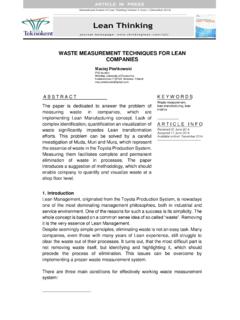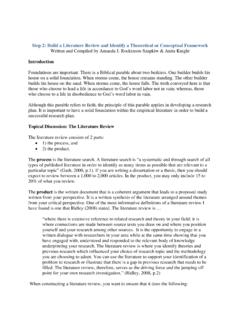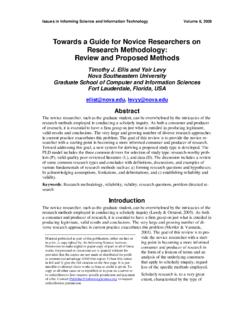Transcription of Single Minute Exchange of Dies: Literature Review
1 I. nte rna ti ona lJo urn alo fLe anT. hin kin gVo lume3. ,Is sue2(. Dec emb er2. 012. ). LeanThi nki ng journalhomepage: nki ngl jlt Single Minute Exchange of Dies: Literature Review *Yash Dave Nagendra Sohani Lecturer Manufacturing Engineering, Dhar Mechanical Engineering, Institute of Polytechnic Dhar ( ), India 454001 Engineering and Technolgy, Devi Ahilya Ph: +91-8878891982 Vishawvidyalya, Indore ( ), India 452001. ABSTRACT KEYWORDS. Lean tools, To survive in cutthroat competition, industries need to reduce Single Minute Exchange of Dies, production time and costs in order to improve operating Quick Changeover performance and flexibility. Single Minute Exchange of Dies (SMED) mainly focuses on recognition of internal and external ARTICLE INFO. activities. Accordingly, this article has as its main objective to Review Received 30 April 2012. the Literature addressing this less studied topic: SMED. This paper Accepted 19 June2012.
2 Available online 01 October 2012. covers the Literature Review of SMED tool and purpose of this Literature Review is to develop an overview of the conceptual framework of SMED tool. The various industrial applications and the existing articles indicate the relevance of the topic and methodology. Flexibility and responsiveness are main pillars of manufacturing, which is operated by demands of greater product variety and improved quality. 1. Introduction and Literature survey Single Minute Exchange of Die (SMED) is one of the many lean production methods for reducing waste in a manufacturing process. It provides a rapid and efficient way of converting a manufacturing process from running the current product to running the next product. This rapid changeover is key to reducing production lot sizes and thereby improving flow. The phrase " Single Minute " does not mean that all changeovers and startups should take only one Minute , but that they should take less than 10 minutes (in other words, " Single digit Minute ").
3 SMED is the term used to represent the Single Minute Exchange of Die or setup time that can be counted in a Single digit of minutes . SMED is often used interchangeably with quick changeover . SMED and quick changeover are the practice of reducing the time it takes to change a line or machine from running one product to the next. The need for SMED and quick changeover programs is more popular now than ever due to increased demand for product variability, reduced product life cycles and the need to significantly reduce inventories. _____. * Corresponding Author DA. VE, S N /. OHA Int er nat i ona lJo urn alo fLe anT. hin kin gVo lume3. ,Is sue2. (De cemb er2. 012. ). Historical Background of SMED. Ohno at Toyota developed SMED in 1950. Ohno`s idea was to develop a system that could Exchange dies in a more speedy way. By the late 1950`s Ohno was able to reduce the time that was required to change dies from a day to three minutes .
4 The basic idea of SMED is to reduce the setup time on a machine. There are two types of setups: internal and external. Internal setup activities are those that can be carried out only while the machine is stopped, while external setup activities are those that can be done while the machine is running. The basic idea is to make as many activities as possible from internal to external and also concluded that setup reduction is a tool which is universally applicable. There has been lot of work done in detail for the SMED. methodology in a textile processing industry and also suggest that the effective implementation of SMED. necessitates a number of fundamental requirements, these are: team work, visual factory control, performance measurement, Kaizen and discussed about the role of manufacturing environment in implementation of SMED. The relationship between changeover and production leveling has also been studied and concluded that as the batch size decreases, the cost of each part will increase, since the changeover time will be spread over fewer parts.
5 This leads to high manufacturing costs when changeover times are high and it also discussed the detail changeover analysis and concluded that in making a part, every degree of freedom of the machine must be specified and fixed. SMED is also used as a tool to improve flexibility and the greatest benefit from reduction in changeover time is the ability to produce parts in smaller batches. The relation between SMED. and equipment design is also correlated and it indicated that SMED is suitable not only for manufacturing improvement but also for equipment development. SMED tool has been successfully used in the pine factory and empirically the result was reduction in setup time from 45 min to 15 min and underlines the importance of lean in the application of Information Technology to manufacturing. New modified improvement framework for lean implementation has also been proposed and lean implementation has been divided it in to waves and put the SMED tool in second wave amongst overall four waves.
6 Shingo states that SMED can be applied in any factory to any machine . Work regarding the application of design changes to the changeover process and the balancing of production lines using the set up minimization. Process of SMED: 1. Observe the current methodology: Current procedures generally recorded on video tape of all the changeover process. It covers the complete changeover from one model to another model. 2. Separate the Internal and External activities: Internal activities are those that can only be performed when the process is stopped, while External activities can be done while the last batch is being produced, or once the next batch has started. 3. Stream line the process of changeover: For each iteration of the above process, a substantial improvement in set-up times should be expected, so it may take several iterations to cross the ten Minute line. 5. Continuous Training: After the successful first iteration of SMED application the prime requirement becomes the training of all the operator of the cell.
7 Training has been given by cell champion (Master of Changeover). {See Figure 1}. 28. DA. VE, S N /. OHA Int er nat i ona lJo urn alo fLe anT. hin kin gVo lume3. ,Is sue2. (De cemb er2. 012. ). (Figure1: Representation of Change over time). (Source: Berna Ulutas , 2011). SMED Terms: Adjustment Waste: Any activities that would cause the machine to cycle in a sample or trial mode which could create a part that must be inspected and then possible scrapped or reworded (Rubrich & Watson, 2004). Batch: A quantity of items that are processed together (Marchwinski & Shook, 2003). Changeover: The process of switching from the production of one product or part number to another in a machine or a series of linked machines by changing parts, dies, molds or fixtures, also called a set-up. Changeover time is measured as the time elapsed between the last piece in the run just completed until the first good piece from the process after the changeover (Marchwinski &.)
8 Shook, 2003). Die Set: This is the tooling that is removed and replaced in a punch press during a changeover. A die set consists of a set of male punches and female dies which, when pressed together either creates a hole in the work piece or forms the work piece creating features desired by the customer. Downtime: Production time lost due to planned and unplanned stoppages. Planned downtime includes scheduled stoppages for such activities as shift start up, production meetings, changeovers to produce other products and scheduled maintenance. Unplanned downtime includes stoppages for breakdowns, machine adjustments, material shortages and absenteeism (Marchwinski &. Shook, 2003). External Setup: That part of the setup which can be done while the machine is still running, for example, preparing a die to be used for the next run (Rubrich & Watson, 2004). Internal Setup: That part of the setup which must be done while the machine is shut down, for example, removing or attaching dies (Rubrich & Watson, 2004).
9 29. DA. VE, S N /. OHA Int er nat i ona lJo urn alo fLe anT. hin kin gVo lume3. ,Is sue2. (De cemb er2. 012. ). Lean Production: A system of production that makes and delivers just what is needed, just when it is needed and just in the amount needed. Lean manufacturing aims for the total elimination of all waste to achieve the best possible quality, lowest possible cost and use of resources, and the lowest possible production and delivery lead times (Marchwinski & Shook, 2003). Lot: A quantity of items that are processed together (Krajewski & Ritzman, 2007). Non-Value Added Activities: The time spent on activities that add costs but no value to an item from the customer's perspective. These are activities that the customer is generally not willing to pay for (Marchwinski & Shook, 2003). Punch Press: A machine tool used to work materials (typically steel) by changing the shape of the raw material. Material shape is changed through application of direct pressure which forces the material to change shape.
10 The function of the punch press is to hold the die set and apply the motion and pressure required to perform value added operations to raw materials. Setup: The process of switching from the production of one product or part number to another in a machine or a series of linked machines by changing parts, dies, molds or fixtures, also called a set-up. Changeover time is measured as the time elapsed between the last piece in the run just completed until the first good piece from the process after the changeover (Marchwinski &. Shook, 2003). Setup Reduction: The process of reducing the amount of time needed to changeover a process from the last part for the previous product to the first good part for the next product (Marchwinski & Shook, 2003). Setup Waste, External: Activities such as searching, locating or moving jigs, tools, bolts, clamps, fasteners, gauges or instructions in the setup area (Rubrich & Watson, 2003).







